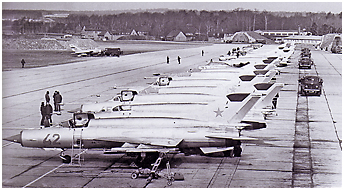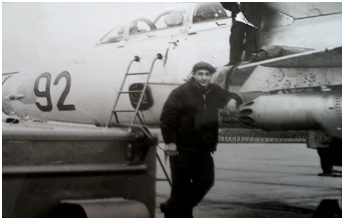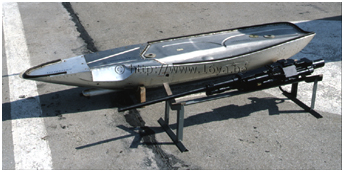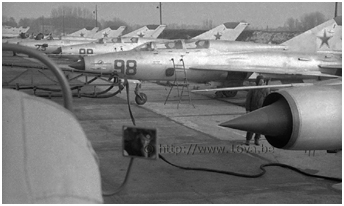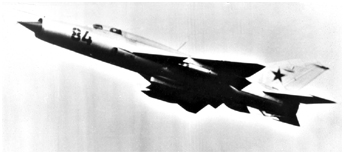
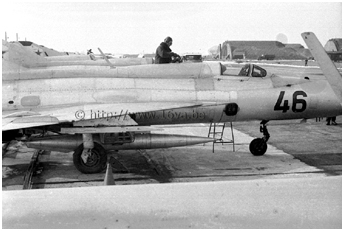 Until now, the presentation of this chapter was organized in an easy-to-follow chronological order given the few aircraft types studied and the standardized equipment of the different units that used them.
But things will now get more complicated due to the study of a larger variety of aircraft as well as their evolution over time. We have therefore chosen from this third part of the chapter dedicated
to the "shturmovik" and fighter-bomber units, to treat each model and its different versions classified by manufacturer, i.e. the MiG-21, -23, -27, then the Su-17 and finally the Su-25.
To keep the chronology in mind, just check the order of battle given in the link further below.
Until now, the presentation of this chapter was organized in an easy-to-follow chronological order given the few aircraft types studied and the standardized equipment of the different units that used them.
But things will now get more complicated due to the study of a larger variety of aircraft as well as their evolution over time. We have therefore chosen from this third part of the chapter dedicated
to the "shturmovik" and fighter-bomber units, to treat each model and its different versions classified by manufacturer, i.e. the MiG-21, -23, -27, then the Su-17 and finally the Su-25.
To keep the chronology in mind, just check the order of battle given in the link further below.
It should also be noted that the abbreviation IBAP designating in Russian language the fighter-bomber aviation regiments became APIB from November 1976. However, it does not change the English interpretation
of the latter.
The MiG-21
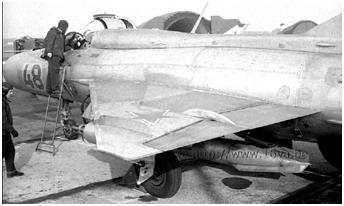
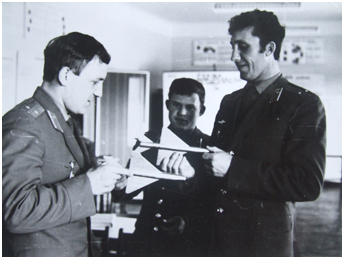 Nouveaux avions, nouveaux modèles didactiques! (730.APIB) © DR
Nouveaux avions, nouveaux modèles didactiques! (730.APIB) © DR
New planes, new didactic models! (730.APIB) © DR
While five regiments (three from the 105.IBAD and two from the 125.IBAD) out of six had largely abandoned their MiG-17F in favor of Su-7B and BM between 1962 and 1974, the 730.IBAP at Neuruppin replaced its "Fresco-C"
with MiG-21PF, (PFS?), PFM and finally SM from 1975.
The German Federal Intelligence Services (BND) indeed reported the landing at Neuruppin of "Fishbed-D and F" coming from the USSR in September of the same year. Although capable of conducting ground attack missions,
the MiG-21PF "Fishbed-D" and PFM "Fishbed-F" were basically interceptors without an internal cannon. These models were the poor relatives the Su-7B/BM of other regiments. Let us judge: they only had three
hardpoints (4 or 6 for the Su-7B/BM) capable of supporting a total of 1500 kg of external stores - in practice one ton under the wings plus a drop tank under the fuselage - while the "Fitter" carried 2000-2500 kg.
It would seem that replacing the old MiG-17F with MiG-21 was only a transitional measure.
Already in 1974, when the 116.GvIBAP got Su-7BM, they were "second-hand" aircraft because the production of the Sukhoi fighter-bomber ceased in 1972 after a last batch of 50 Su-7BKL. The same phenomenon
was observed within the 149.IBAD of the 4.VA in Poland, when the 42.GvIBAP received MiG-21PF in 1972, while the other two regiments of the division, the 3. and 83.IBAP were equipped with Su-7Bs since 1960/61.
However, it should be mentioned that other units, all based in the USSR and therefore a priori in the second line of defence, were re-equipped - or even established - with Su-7B/BM/BKL/BMK in the second half of the 1970s,
probably with aircraft made available after the re-equipment of other regiments with for example MiG-27 or Su-17.
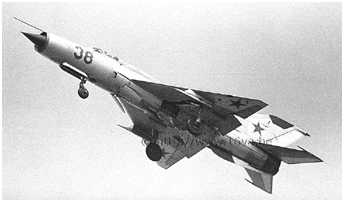
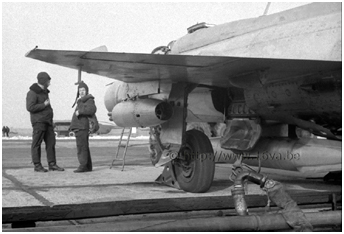 The MiG-21PF (Izdelie or Product 76) whose production began at the N°21 factory in Gorki (currently Nizhny Novgorod) in 1961 was a second generation interceptor, succeeding the
MiG-21F and F-13 "Fishbed-C ."
As such, its avionics included, like the MiG-21PFM discussed below, a Lazur (Azur) interface that received datalink commands from ground control centers,
indicating to the pilot the parameters to follow to intercept a target. The initial RP-9-21 radar was later replaced by the RP-21 Sapfir-21 intercept radar.
Initially, only two R-3S (AA-2A "Atoll") air-to-air missiles with infrared guidance could be used. The adaptation of the RP-21 radar or the retrofitting of the RP-21M - especially on export models -
then enabled it to carry RS-2-US (AA-1 "Alkali") missiles, better suited to bad weather than the R-3S.
A PTB-490 fuel tank certified up to Mach 1.6 usually took place under the belly of the aircraft, however, it also was possible to attach a PTB-800 instead.
In fighter-bomber configuration (the PKI-1 optical collimator was used as a sight for the air-to-ground armament), it naturally carried under the wings either classic UB-16-57U rocket-launcher pods
with a capacity of 16 S-5M or S-5K rockets, either 50 to 500 kg bombs or two S-24 rockets. With a speed of 2175 km/h at 12500 meters and 1300 km/h at sea level, its performance was comparable to that of the Su-7B.
Lighter - 5150 kg empty against 8370 kg - and smaller - 7m15 wingspan against 9m31 - the MiG-21PF logically had a less powerful Tumanski R-11F2-300 engine with a thrust of 3950 kg dry (against 6300) and 6120 kg with
afterburner (against 9200). The "Fishbed-D" had a one-piece canopy that swung forward like on the MiG-21F/F-13 as well as a vertical fin with a narrow chord. A fairing housing avionics and an 80 liter fuel tank were
mounted behind the cockpit.
The MiG-21PF (Izdelie or Product 76) whose production began at the N°21 factory in Gorki (currently Nizhny Novgorod) in 1961 was a second generation interceptor, succeeding the
MiG-21F and F-13 "Fishbed-C ."
As such, its avionics included, like the MiG-21PFM discussed below, a Lazur (Azur) interface that received datalink commands from ground control centers,
indicating to the pilot the parameters to follow to intercept a target. The initial RP-9-21 radar was later replaced by the RP-21 Sapfir-21 intercept radar.
Initially, only two R-3S (AA-2A "Atoll") air-to-air missiles with infrared guidance could be used. The adaptation of the RP-21 radar or the retrofitting of the RP-21M - especially on export models -
then enabled it to carry RS-2-US (AA-1 "Alkali") missiles, better suited to bad weather than the R-3S.
A PTB-490 fuel tank certified up to Mach 1.6 usually took place under the belly of the aircraft, however, it also was possible to attach a PTB-800 instead.
In fighter-bomber configuration (the PKI-1 optical collimator was used as a sight for the air-to-ground armament), it naturally carried under the wings either classic UB-16-57U rocket-launcher pods
with a capacity of 16 S-5M or S-5K rockets, either 50 to 500 kg bombs or two S-24 rockets. With a speed of 2175 km/h at 12500 meters and 1300 km/h at sea level, its performance was comparable to that of the Su-7B.
Lighter - 5150 kg empty against 8370 kg - and smaller - 7m15 wingspan against 9m31 - the MiG-21PF logically had a less powerful Tumanski R-11F2-300 engine with a thrust of 3950 kg dry (against 6300) and 6120 kg with
afterburner (against 9200). The "Fishbed-D" had a one-piece canopy that swung forward like on the MiG-21F/F-13 as well as a vertical fin with a narrow chord. A fairing housing avionics and an 80 liter fuel tank were
mounted behind the cockpit.
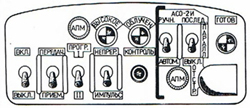
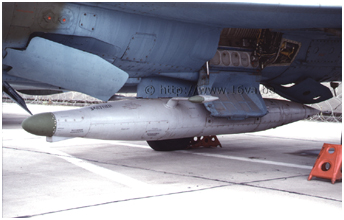 The fact that the MiG-21PF could also use an SPS-141 ECM pod fixed to the ventral attachment point is little known but proven by technical documentation. While the Su-7B/BM, and later the Su-17 also carried
this pod, its shape differed from one plane to another depending on its internal equipment. Thus, the model used with the MiG-21s resembled a flattened tank with an antenna attached on each side. In addition, ASO-2I
flare launchers containing 64 IR flares were located in its rear part. This pod could not be dropped in flight. The pod control was done via a control box mounted at the top of the arch of the windshield.
The MiG-21PF continued its development with various modifications such as increasing the surface of the vertical fin. However, the main one was to take air from the reactor at the level of the sixth stage of the compressor
in order to blow the flaps and thus reduce the landing speed which decreased from about 290 to 250 km/h, finally giving birth to the MiG-21PFS or Product 94. The letter S referred to the "boundary layer blowing system"
(Sduva Pogranishnogo Sloya) (1) of the flaps. That system was subsequently mounted on all the following MiG-21 versions.
The reactor suitable for this task took the designation R-11F2S-300. However, it was not until the final evolution of the MiG-21PFS that the system was used for good.
A larger, cruciform brake parachute was housed inside a pointed fairing located at the base of the vertical fin instead of underside the fuselage.
The parachute could be deployed just prior to touchdown, as it generated a nose-up position opposite to the aircraft's previous attitude.
Two SPRD-99 rockets (> Link) of 2500 kgp usable for 17 seconds were likely to be fixed under the rear fuselage in order to reduce the take-off run.
The fact that the MiG-21PF could also use an SPS-141 ECM pod fixed to the ventral attachment point is little known but proven by technical documentation. While the Su-7B/BM, and later the Su-17 also carried
this pod, its shape differed from one plane to another depending on its internal equipment. Thus, the model used with the MiG-21s resembled a flattened tank with an antenna attached on each side. In addition, ASO-2I
flare launchers containing 64 IR flares were located in its rear part. This pod could not be dropped in flight. The pod control was done via a control box mounted at the top of the arch of the windshield.
The MiG-21PF continued its development with various modifications such as increasing the surface of the vertical fin. However, the main one was to take air from the reactor at the level of the sixth stage of the compressor
in order to blow the flaps and thus reduce the landing speed which decreased from about 290 to 250 km/h, finally giving birth to the MiG-21PFS or Product 94. The letter S referred to the "boundary layer blowing system"
(Sduva Pogranishnogo Sloya) (1) of the flaps. That system was subsequently mounted on all the following MiG-21 versions.
The reactor suitable for this task took the designation R-11F2S-300. However, it was not until the final evolution of the MiG-21PFS that the system was used for good.
A larger, cruciform brake parachute was housed inside a pointed fairing located at the base of the vertical fin instead of underside the fuselage.
The parachute could be deployed just prior to touchdown, as it generated a nose-up position opposite to the aircraft's previous attitude.
Two SPRD-99 rockets (> Link) of 2500 kgp usable for 17 seconds were likely to be fixed under the rear fuselage in order to reduce the take-off run.
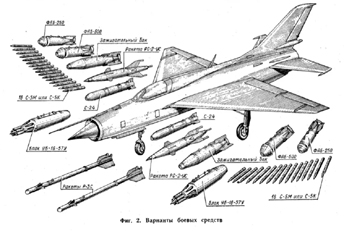
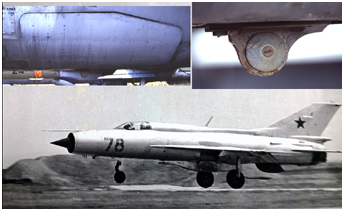 From the twentieth production batch, the MiG-21PFS changed its designation to become the MiG-21PFM. The designation change seems to be linked to the systematic mounting of the RP-21M radar and the SPS
system. The MiG-21PFM retained the same product number as the MiG-21PFS - i.e. 94. While the first MiG-21PFM could have some external features partly similar to the MiG-21PF/PFS, the final model was characterized by a wide
chord vertical fin of similar dimensions to later versions of the "Fishbed", as well as by a new two-piece canopy with a fixed windshield and a second part tilting to the right side to access the cockpit. This change had been
necessary because of the characteristics of the new KM-1 ejection seat which enabled ejection on the ground at 130 km/h and in flight up to 1100 km/h. Some MiG-21PF, PFS and PFM had an additional dedicated ventral attachment
point allowing them to carry a GP-9 gun pod including a GSh-23L twin barrel gun and its 200 shells.
The Kh-66 or AS-7 "Kerry" air-to-surface missile (> Link) was added to the armament array of the MiG-21PFM from 1968.
The missile required good visibility to be fired and its range varied from 3 to 10 km. Its weight was 278 kg including 51 kg of explosives. The Kh-66 was fired during a dive at 30° and guided by the radar in fixed beam mode;
the pilot had to point a the target using the PKI-1 collimator as if he was firing a cannon. The Kh-66 was compatible with the weapon system of the MiG-21PFM because the latter was capable of firing RS-2-US missiles from which
the Kh-66 was derived (in fact, the Kh-66 could only be fired by aircraft equipped with the RP-21 radar), the two missiles using the same principle of guidance by following the fixed beam of the radar.
The radar-less Su-7B/BM could not fire the Kh-66.
From the twentieth production batch, the MiG-21PFS changed its designation to become the MiG-21PFM. The designation change seems to be linked to the systematic mounting of the RP-21M radar and the SPS
system. The MiG-21PFM retained the same product number as the MiG-21PFS - i.e. 94. While the first MiG-21PFM could have some external features partly similar to the MiG-21PF/PFS, the final model was characterized by a wide
chord vertical fin of similar dimensions to later versions of the "Fishbed", as well as by a new two-piece canopy with a fixed windshield and a second part tilting to the right side to access the cockpit. This change had been
necessary because of the characteristics of the new KM-1 ejection seat which enabled ejection on the ground at 130 km/h and in flight up to 1100 km/h. Some MiG-21PF, PFS and PFM had an additional dedicated ventral attachment
point allowing them to carry a GP-9 gun pod including a GSh-23L twin barrel gun and its 200 shells.
The Kh-66 or AS-7 "Kerry" air-to-surface missile (> Link) was added to the armament array of the MiG-21PFM from 1968.
The missile required good visibility to be fired and its range varied from 3 to 10 km. Its weight was 278 kg including 51 kg of explosives. The Kh-66 was fired during a dive at 30° and guided by the radar in fixed beam mode;
the pilot had to point a the target using the PKI-1 collimator as if he was firing a cannon. The Kh-66 was compatible with the weapon system of the MiG-21PFM because the latter was capable of firing RS-2-US missiles from which
the Kh-66 was derived (in fact, the Kh-66 could only be fired by aircraft equipped with the RP-21 radar), the two missiles using the same principle of guidance by following the fixed beam of the radar.
The radar-less Su-7B/BM could not fire the Kh-66.
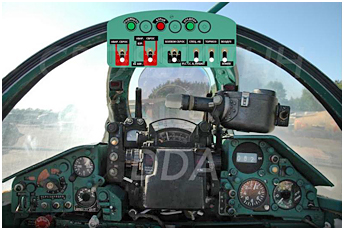 But the MiG-21PFM had another advantage in its game: it was the first version of the MiG-21 capable of dropping "special weapons" - provided that it had been modified with the addition of a small cavity under the belly
and that the electrical wiring had been adapted. As similar aircraft were delivered to Poland, Romania and Czechoslovakia, it is reasonable to assume that they also served in the 16.VA with the 730.APIB or fighter units
with a secondary nuclear mission. A block consisting of four switches controlling relays was integrated into the right side of the cockpit. In addition, a special control box was mounted at the top of the windshield arch
(also read "Special weapons, part 2"), where was also attached to other
aircraft that of the GP-9 gun pod when it was mounted, or that of the SPS-141E pod, the latter easily being confused with the nuclear control box because of its identical shape.
An RN-28 nuke (2) could be fixed at the ventral point, attached to a BD3-66-21N dedicated pylon almost identical to the MiG-23 nuclear pylon given in a link further below.
Since the DZ-57D bomb latch mechanism protruded above the pylon, the carrier aircraft had to be modified so that the latter could fit under the fuselage.
But the MiG-21PFM had another advantage in its game: it was the first version of the MiG-21 capable of dropping "special weapons" - provided that it had been modified with the addition of a small cavity under the belly
and that the electrical wiring had been adapted. As similar aircraft were delivered to Poland, Romania and Czechoslovakia, it is reasonable to assume that they also served in the 16.VA with the 730.APIB or fighter units
with a secondary nuclear mission. A block consisting of four switches controlling relays was integrated into the right side of the cockpit. In addition, a special control box was mounted at the top of the windshield arch
(also read "Special weapons, part 2"), where was also attached to other
aircraft that of the GP-9 gun pod when it was mounted, or that of the SPS-141E pod, the latter easily being confused with the nuclear control box because of its identical shape.
An RN-28 nuke (2) could be fixed at the ventral point, attached to a BD3-66-21N dedicated pylon almost identical to the MiG-23 nuclear pylon given in a link further below.
Since the DZ-57D bomb latch mechanism protruded above the pylon, the carrier aircraft had to be modified so that the latter could fit under the fuselage.
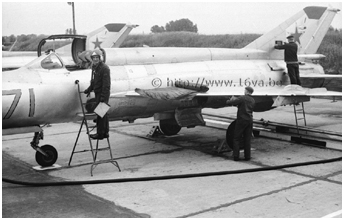
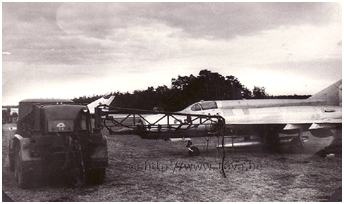 The last type of MiG-21 that joined the ranks of the 730.APIB was the MiG-21SM (Product 95M, later 15 for paranoid security reasons) "Fishbed-J" whose first flight dates back to 1967.
The export version designated Product 96F was the MiG-21MF. The MiG-21SM remained in service with the regiment until the early eighties. It was in July 1980 that the first Su-17M from the 20.GvAPIB were transferred
to the 730.APIB to replace the MiG-21SM. Quite logically, this aircraft derived from the MiG-21S (Product 95) "Fishbed-J" itself derived from the MiG-21R (Product 94R, later 03) "Fishbed-H," from which it inherited a
continuous dorsal fairing between the cockpit and the vertical fin housing a larger fuel tank, benefited from many improvements. Its R13-300 reactor had a thrust of 4070 kg dry and 6490 kg with the afterburner fully engaged.
The thrust of the latter could be controlled and the takeoff was generally carried out with half afterburner in order to save fuel. The more capable RP-22S Sapfir-21 radar was associated with new air-to-air missiles.
These were the R-3R (AA-2B/D "Atoll") with semi-active radar guidance and the R-13M (AA-2C "Atoll") with IR guidance. Firing R-3S missiles remained possible, while IR-guided R-60 (AA-8 "Aphid") missiles were adapted later -
R-60 were observed for the first time by the USMLM at Zerbst on MiG-23M of the 35.IAP in March 1976.
The last type of MiG-21 that joined the ranks of the 730.APIB was the MiG-21SM (Product 95M, later 15 for paranoid security reasons) "Fishbed-J" whose first flight dates back to 1967.
The export version designated Product 96F was the MiG-21MF. The MiG-21SM remained in service with the regiment until the early eighties. It was in July 1980 that the first Su-17M from the 20.GvAPIB were transferred
to the 730.APIB to replace the MiG-21SM. Quite logically, this aircraft derived from the MiG-21S (Product 95) "Fishbed-J" itself derived from the MiG-21R (Product 94R, later 03) "Fishbed-H," from which it inherited a
continuous dorsal fairing between the cockpit and the vertical fin housing a larger fuel tank, benefited from many improvements. Its R13-300 reactor had a thrust of 4070 kg dry and 6490 kg with the afterburner fully engaged.
The thrust of the latter could be controlled and the takeoff was generally carried out with half afterburner in order to save fuel. The more capable RP-22S Sapfir-21 radar was associated with new air-to-air missiles.
These were the R-3R (AA-2B/D "Atoll") with semi-active radar guidance and the R-13M (AA-2C "Atoll") with IR guidance. Firing R-3S missiles remained possible, while IR-guided R-60 (AA-8 "Aphid") missiles were adapted later -
R-60 were observed for the first time by the USMLM at Zerbst on MiG-23M of the 35.IAP in March 1976.
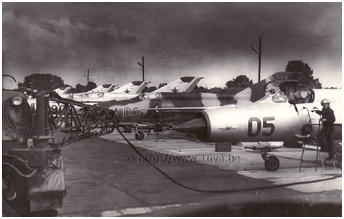
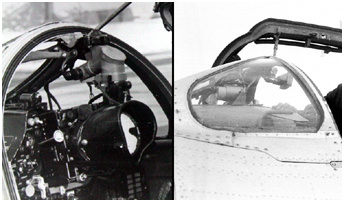 The MiG-21SM had four wing pylons for bombs and missiles, however, those located outboard could also carry drop tanks. The maximum load was nevertheless limited to 1300 kg. Besides the classic UB-16-57U rocket pods,
the "Fishbed-J" also could fire S-8 unguided rockets from UB-32A pods. The MiG-21SM was the first "Fishbed" version intended for the VVS armed with a GSh-23L gun recessed under the belly
(3).
Installing a cannon had required the addition of small fences mounted under the auxiliary air intakes of the reactor located in front of the wings root so that they did not open untimely during firing.
The PVD-7 nose boom of the pitot tube on the MiG-21SM also included sensors indicating the angles of attack and sideslip useful for the weapon system and the accuracy of firing. The pilot had an indication of the angle
of attack of his aircraft via the sensor of the DUA-3 probe mounted on the left side of the nose, installed on all single-seaters since the MiG-21R.
The "Fishbed-J" inherited an improved "Lazur-M" ground control system, like the models studied above. The new ASP-PFD-21 gyro-stabilized sight increased firing accuracy but was limited to 2.75G during gun sighting.
In addition to carrying an SPS-141 ECM pod and its IR decoys, the aircraft self-protection was provided by an SPO-10 Sirena-2 radar warning receiver.
The MiG-21SM also had a nuclear capability. A control box mounted above the windshield arch also was required. It was different from that of the MiG-21PFM, but similar to that which would later equip the MiG-21SMT and bis,
except for a few details (> Link).
The MiG-21SM had four wing pylons for bombs and missiles, however, those located outboard could also carry drop tanks. The maximum load was nevertheless limited to 1300 kg. Besides the classic UB-16-57U rocket pods,
the "Fishbed-J" also could fire S-8 unguided rockets from UB-32A pods. The MiG-21SM was the first "Fishbed" version intended for the VVS armed with a GSh-23L gun recessed under the belly
(3).
Installing a cannon had required the addition of small fences mounted under the auxiliary air intakes of the reactor located in front of the wings root so that they did not open untimely during firing.
The PVD-7 nose boom of the pitot tube on the MiG-21SM also included sensors indicating the angles of attack and sideslip useful for the weapon system and the accuracy of firing. The pilot had an indication of the angle
of attack of his aircraft via the sensor of the DUA-3 probe mounted on the left side of the nose, installed on all single-seaters since the MiG-21R.
The "Fishbed-J" inherited an improved "Lazur-M" ground control system, like the models studied above. The new ASP-PFD-21 gyro-stabilized sight increased firing accuracy but was limited to 2.75G during gun sighting.
In addition to carrying an SPS-141 ECM pod and its IR decoys, the aircraft self-protection was provided by an SPO-10 Sirena-2 radar warning receiver.
The MiG-21SM also had a nuclear capability. A control box mounted above the windshield arch also was required. It was different from that of the MiG-21PFM, but similar to that which would later equip the MiG-21SMT and bis,
except for a few details (> Link).
| ORBAT 1976 - 1994 |
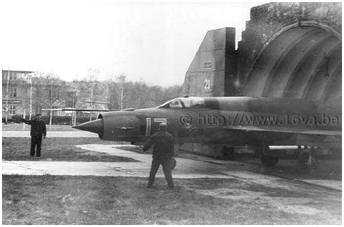 The MiG-21SMT "Fishbed-K" (Product 50) equipped four fighter aviation regiments of the 16.VA: the 33., 35., 85.Gv and 296.IAP. However, in 1982, the Altenburg-based 296.IAP was transformed into
a fighter-bomber unit. A priori, it remained under the command of its fighter division, the 6.GvIAD.
The 296.APIB kept its MiG-21SMT until 1983 (its aircraft were transferred to the 228.UAP > Link),
when the latter started to be replaced by MiG-27.
The MiG-21SMT "Fishbed-K" (Product 50) equipped four fighter aviation regiments of the 16.VA: the 33., 35., 85.Gv and 296.IAP. However, in 1982, the Altenburg-based 296.IAP was transformed into
a fighter-bomber unit. A priori, it remained under the command of its fighter division, the 6.GvIAD.
The 296.APIB kept its MiG-21SMT until 1983 (its aircraft were transferred to the 228.UAP > Link),
when the latter started to be replaced by MiG-27.
The MiG-21SMT has its origins in the MiG-21MT (Product 96T - T for Toplivo, fuel - later Product 96B) developed for export. Based on the MiG-21M or MF airframe, it was equipped with a R13F-300 reactor with a new afterburner unit comprising an "emergency" mode (increased thrust). The main target of the engineers with the MiG-21MT was to give the "Fishbed" a bigger range. To this end, three fuel tanks with a total capacity of 900 liters were mounted on the back of the aircraft, thus giving rise to a considerable widening of the dorsal fairing, not without harmful consequences on its behavior in flight. Only 15 MiG-21MT were manufactured by the Moscow-based factory n°30 but none were exported. They served instead within the VVS, starting with the 234.GvIAP at Kubinka, and, according to a testimony, equipping afterwards a squadron of the 296.APIB before ending their career with the 66.APIB at Veshchevo in the Leningrad Military District.
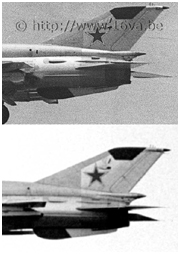 However, the 296.APIB essentially was equipped with MiG-21SMT that also ensured a nuclear mission. The "Fishbed-K" was a MiG-21SM with the large spine of the MT and a R13F-300 reactor.
Therefore, it had the same external characteristics as the MiG-21MT. With a total fuel capacity of 3250 liters, the range was increased from 200 to 250 km. However, most of the other parameters such as the ceiling or the
climbing time were degraded. Consequently, the fuel capacity of the dorsal fuel tanks was reduced to 600 liters and the spine fairing size also was reduced accordingly. The latter ended where the brake parechute fairing
started - this type of fairing also was mounted on the MiG-21bis that followed the MiG-21SMT. On 281 MiG-21SMT assembled by the Gorky factory between 1971 and 1973, only 156 had been built with the large spine (900 liters)
when the production was shifted towards aircraft with the smaller spine (600 liters) that kept the MiG-21SMT designation.
Another fighter regiment, the 35.IAP, was converted into a fighter-bomber unit in 1982 (see further below). Thus, between 1982 and 1984, the 16.VA had eight APIBs in its ranks instead of six.
One can wonder about the reason for the transformation of two fighter regiments into fighter-bomber units.
However, the 296.APIB essentially was equipped with MiG-21SMT that also ensured a nuclear mission. The "Fishbed-K" was a MiG-21SM with the large spine of the MT and a R13F-300 reactor.
Therefore, it had the same external characteristics as the MiG-21MT. With a total fuel capacity of 3250 liters, the range was increased from 200 to 250 km. However, most of the other parameters such as the ceiling or the
climbing time were degraded. Consequently, the fuel capacity of the dorsal fuel tanks was reduced to 600 liters and the spine fairing size also was reduced accordingly. The latter ended where the brake parechute fairing
started - this type of fairing also was mounted on the MiG-21bis that followed the MiG-21SMT. On 281 MiG-21SMT assembled by the Gorky factory between 1971 and 1973, only 156 had been built with the large spine (900 liters)
when the production was shifted towards aircraft with the smaller spine (600 liters) that kept the MiG-21SMT designation.
Another fighter regiment, the 35.IAP, was converted into a fighter-bomber unit in 1982 (see further below). Thus, between 1982 and 1984, the 16.VA had eight APIBs in its ranks instead of six.
One can wonder about the reason for the transformation of two fighter regiments into fighter-bomber units.
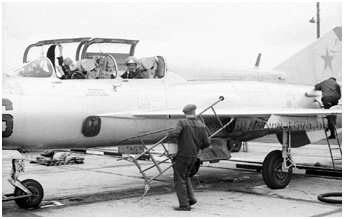 While the MiG-21 units still kept some UTI MiG-15 for a long time for service and training tasks, they were of course all equipped with the different two-seater variants of the "Fishbed."
Given the late entry into service of the MiG-21 within the 730. and 296.APIB, it is unlikely that these units were equipped with the first two-seater version of the fighter, designated MiG-21U (Product 66)
"Mongol-A". The latter had a vertical fin with a narrow chord and the brake-chute located under the rear fuselage. The engine was a R11F-300 reactor. The production of this first two-seater variant
started at factory n°31 in Tbilisi in 1962. The next version, still designated MiG-21U (Product 66-400) was called "Mongol-B" in the West because of its different appearance. It indeed stood out
by its wide chord vertical fin and the relocation of the brake-chute at the base of the latter, as on the MiG-21PFS and PFM. In 1966, it was the turn of the MiG-21US (Product 68) "Mongol-B" to enter the scene.
As in the case of the MiG-21PFS, the letter S indicated the installation of the flaps boundary layer blowing system. Here also, the reactor mounted was a R-11F2S-300. In addition to this difference which is not obvious,
a small external detail made it possible to distinguish it from the 66-400 product: the retractable mirror mounted above the rear cockpit. Two modifications of the KM-1 ejection seat were also part of the new equipment.
The ultimate variant of the two-seat version of the MiG-21, designated MiG-21UM (Product 69) "Mongol-B" entered production in Tbilisi in 1971.
This model, which was formally identified within the ground attack squadrons of the 16.VA, was characterized in particular by its R13-300 reactor. Two external characteristics made it possible to distinguish
it from its congeners: the antenna of the R-802 VHF radio (as on the MiG-21PFM) and the DUA-3 angle of attack probe (here for the pilot and his pupil) mounted on the left side of the nose as on single-seaters.
The various two-seater versions had only two wing pylons and a ventral attachment point. Devoid of an internal gun and unable to carry the GP-9 gun pod, the two-seaters could however receive a smaller conformal rounded pod
mounted under the fuselage, which housed an Afanas'yev 12.7 mm machine gun and its 60 projectiles.
While the MiG-21 units still kept some UTI MiG-15 for a long time for service and training tasks, they were of course all equipped with the different two-seater variants of the "Fishbed."
Given the late entry into service of the MiG-21 within the 730. and 296.APIB, it is unlikely that these units were equipped with the first two-seater version of the fighter, designated MiG-21U (Product 66)
"Mongol-A". The latter had a vertical fin with a narrow chord and the brake-chute located under the rear fuselage. The engine was a R11F-300 reactor. The production of this first two-seater variant
started at factory n°31 in Tbilisi in 1962. The next version, still designated MiG-21U (Product 66-400) was called "Mongol-B" in the West because of its different appearance. It indeed stood out
by its wide chord vertical fin and the relocation of the brake-chute at the base of the latter, as on the MiG-21PFS and PFM. In 1966, it was the turn of the MiG-21US (Product 68) "Mongol-B" to enter the scene.
As in the case of the MiG-21PFS, the letter S indicated the installation of the flaps boundary layer blowing system. Here also, the reactor mounted was a R-11F2S-300. In addition to this difference which is not obvious,
a small external detail made it possible to distinguish it from the 66-400 product: the retractable mirror mounted above the rear cockpit. Two modifications of the KM-1 ejection seat were also part of the new equipment.
The ultimate variant of the two-seat version of the MiG-21, designated MiG-21UM (Product 69) "Mongol-B" entered production in Tbilisi in 1971.
This model, which was formally identified within the ground attack squadrons of the 16.VA, was characterized in particular by its R13-300 reactor. Two external characteristics made it possible to distinguish
it from its congeners: the antenna of the R-802 VHF radio (as on the MiG-21PFM) and the DUA-3 angle of attack probe (here for the pilot and his pupil) mounted on the left side of the nose as on single-seaters.
The various two-seater versions had only two wing pylons and a ventral attachment point. Devoid of an internal gun and unable to carry the GP-9 gun pod, the two-seaters could however receive a smaller conformal rounded pod
mounted under the fuselage, which housed an Afanas'yev 12.7 mm machine gun and its 60 projectiles.
The MiG-23
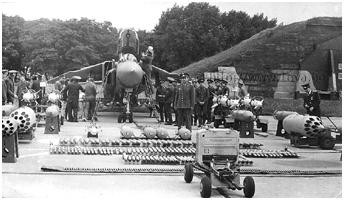
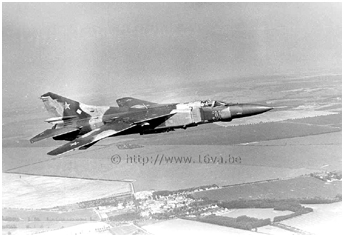 As already mentioned above, the 35.IAP based at Zerbst was transformed into a ground attack unit in 1982, thus becoming the 35.APIB. This conversion was of short duration, since the regiment was again an IAP in 1989 when
it had already been re-equipped with MiG-29. In 1982, the aircraft in service with the 35.APIB was the MiG-23M (Product 23-11M, later 2M) "Flogger-B" with a variable geometry wing. It succeeded the
MiG-23S (Product 23-11) "Flogger-A" that was the first mass-produced version of the MiG-23. The MiG-23MS and MF were export versions of the MiG-23M. Approximately 1300 exemplars of the "Flogger-B," including export aircraft,
were built by the "Znamya Truda" (labor banner) factory in Moscow between 1972 and 1978.
It was powered by a Khachaturov R29-300 reactor of 8300 kgp dry and up to 12500 kgp with adjustable afterburner. Its powerful Sapfir-23 radar (RP-23 then Sapfir-23D and finally -23D-III) was a significant
improvement. In addition, a TP-23 passive IR sensor was mounted under the nose (see > The IR sensors of the "Flogger-G"). An SPO-10 Sirena radar warning receiver
protected the aircraft. As a fighter, besides its GSh-23L ventral gun, the MiG-23M could fire in addition to R-13M
and R-3S missiles, medium-range radar-guided R-23R and IR-guided R-23T mounted under two pylons attached under the wing gloves, as well as short-range R-60 mounted to single or twin launchers attached to the two
pylons located under the fuselage at the level of the air intakes. A central pylon under the fuselage made it possible to carry a fuel tank. Aircraft equipped with a so-called type 3 wing could, in addition to a PTB-800 fuel
tank under the fuselage, carry two other similar tanks attached under the mobile part of the wing set at the minimum deflection of 16°. The pylons of the latter not being able to pivot with the wing, were dropped with
the fuel tanks thanks to explosive bolts if necessary.
Air-to-ground armament included Kh-23 (AS-7 "Kerry") missiles - one under each wing - which required the carriage of a Del'ta-NG guidance pod mounted under the fuselage (photo of a MiG-27D with this pod
> Link). Up to four UB-16-57U, UB-32A or B-8M1 rocket pods or S-24 rockets could be fixed under the four available pylons as well as bombs for a maximum of 2000 kg.
The MiG-23M was also likely to be used as a nuclear vector. Such was already the case within the 35.IAP: read on this subject the fourth paragraph of the 3rd part of the chapter dedicated to the special weapons
> Link. Like on the Su-7 and the Su-17, a 30kt RN-40 nuclear bomb was attached under the fuselage on the
left side to a dedicated BD3-66-23N pylon (> Link) very similar to that of the nuclear MiG-21.
As already mentioned above, the 35.IAP based at Zerbst was transformed into a ground attack unit in 1982, thus becoming the 35.APIB. This conversion was of short duration, since the regiment was again an IAP in 1989 when
it had already been re-equipped with MiG-29. In 1982, the aircraft in service with the 35.APIB was the MiG-23M (Product 23-11M, later 2M) "Flogger-B" with a variable geometry wing. It succeeded the
MiG-23S (Product 23-11) "Flogger-A" that was the first mass-produced version of the MiG-23. The MiG-23MS and MF were export versions of the MiG-23M. Approximately 1300 exemplars of the "Flogger-B," including export aircraft,
were built by the "Znamya Truda" (labor banner) factory in Moscow between 1972 and 1978.
It was powered by a Khachaturov R29-300 reactor of 8300 kgp dry and up to 12500 kgp with adjustable afterburner. Its powerful Sapfir-23 radar (RP-23 then Sapfir-23D and finally -23D-III) was a significant
improvement. In addition, a TP-23 passive IR sensor was mounted under the nose (see > The IR sensors of the "Flogger-G"). An SPO-10 Sirena radar warning receiver
protected the aircraft. As a fighter, besides its GSh-23L ventral gun, the MiG-23M could fire in addition to R-13M
and R-3S missiles, medium-range radar-guided R-23R and IR-guided R-23T mounted under two pylons attached under the wing gloves, as well as short-range R-60 mounted to single or twin launchers attached to the two
pylons located under the fuselage at the level of the air intakes. A central pylon under the fuselage made it possible to carry a fuel tank. Aircraft equipped with a so-called type 3 wing could, in addition to a PTB-800 fuel
tank under the fuselage, carry two other similar tanks attached under the mobile part of the wing set at the minimum deflection of 16°. The pylons of the latter not being able to pivot with the wing, were dropped with
the fuel tanks thanks to explosive bolts if necessary.
Air-to-ground armament included Kh-23 (AS-7 "Kerry") missiles - one under each wing - which required the carriage of a Del'ta-NG guidance pod mounted under the fuselage (photo of a MiG-27D with this pod
> Link). Up to four UB-16-57U, UB-32A or B-8M1 rocket pods or S-24 rockets could be fixed under the four available pylons as well as bombs for a maximum of 2000 kg.
The MiG-23M was also likely to be used as a nuclear vector. Such was already the case within the 35.IAP: read on this subject the fourth paragraph of the 3rd part of the chapter dedicated to the special weapons
> Link. Like on the Su-7 and the Su-17, a 30kt RN-40 nuclear bomb was attached under the fuselage on the
left side to a dedicated BD3-66-23N pylon (> Link) very similar to that of the nuclear MiG-21.
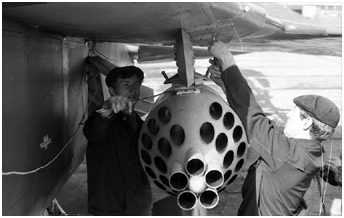
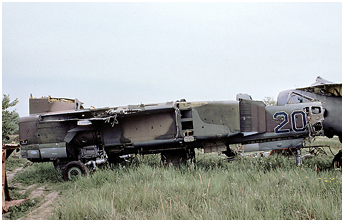 The regiment's MiG-23M left the GDR in August 1989, joining the storage base located at Step' in Eastern Siberia via Damgarten, Starokonstantinov (Ukraine), Kotel'nikovo, Totskoye, Kustanay (now Kostanay - Kazakhstan),
Kamen'-na-Obi and Kansk. The same month 15 MiG-29 (9-12 models of the 7th series with tail keels) left the 968.IAP of Altenburg for Zerbst. About 15 other 9-12 models of the 10th and 12th series coming from the 91.IIAP
of Lipetsk also joined the ranks of the regiment. Other MiG-29 of the 9-13 model from the 73.GvIAP based at Köthen were also accepted into the regiment, which became a fighter unit again
(> Photos). If the distribution of the aircraft resembles a game of musical chairs, the same was true for the pilots, causing discontent
among them. The MiG-23M pilots of the 35.APIB did not indeed have the opportunity to start a MiG-29 conversion course, since others took their place. In 1985, the 53.GvIAP based in Siauliai in Lithuania had swapped
its MiG-23M for the MiG-29. In 1989, the unit had to abandon its "Fulcrums" for "Floggers" as it was destined to become a fighter-bomber regiment.
Also, it was decided in controversial circumstances according to various testimonies, to exchange the pilots rather than to retrain them. This is how about fifty pilots of the 53.GvIAP, in the process of becoming the 53.GvAPIB,
left for the 35.IAP in Zerbst but without their planes transferred elsewhere... As for the Zerbst pilots, they were sent by train to Siauliai - before joining Lipetsk to carry out their conversion on MiG-27K!
The regiment's MiG-23M left the GDR in August 1989, joining the storage base located at Step' in Eastern Siberia via Damgarten, Starokonstantinov (Ukraine), Kotel'nikovo, Totskoye, Kustanay (now Kostanay - Kazakhstan),
Kamen'-na-Obi and Kansk. The same month 15 MiG-29 (9-12 models of the 7th series with tail keels) left the 968.IAP of Altenburg for Zerbst. About 15 other 9-12 models of the 10th and 12th series coming from the 91.IIAP
of Lipetsk also joined the ranks of the regiment. Other MiG-29 of the 9-13 model from the 73.GvIAP based at Köthen were also accepted into the regiment, which became a fighter unit again
(> Photos). If the distribution of the aircraft resembles a game of musical chairs, the same was true for the pilots, causing discontent
among them. The MiG-23M pilots of the 35.APIB did not indeed have the opportunity to start a MiG-29 conversion course, since others took their place. In 1985, the 53.GvIAP based in Siauliai in Lithuania had swapped
its MiG-23M for the MiG-29. In 1989, the unit had to abandon its "Fulcrums" for "Floggers" as it was destined to become a fighter-bomber regiment.
Also, it was decided in controversial circumstances according to various testimonies, to exchange the pilots rather than to retrain them. This is how about fifty pilots of the 53.GvIAP, in the process of becoming the 53.GvAPIB,
left for the 35.IAP in Zerbst but without their planes transferred elsewhere... As for the Zerbst pilots, they were sent by train to Siauliai - before joining Lipetsk to carry out their conversion on MiG-27K!
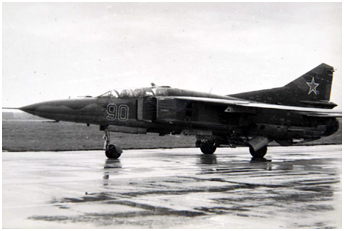
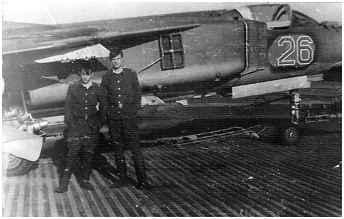 If the 35.APIB undoubtedly still used UTI MiG-15, it had of course some MiG-23UB "Flogger-C" (Product 23-51, later 2U) two-seaters in its ranks. This model was powered by the reactor of the MiG-23S in a more powerful version
designated R-27F2M-300 of 9700 kgp dry and 10000 with afterburner. The firing of R-3S and R-13M IR-guided missiles was possible. Nevertheless, the RP-22S radar of the first models being unreliable, it was no longer mounted and replaced
by a counterweight. This aircraft had the ventral gun and the same number of armament pylons as the single-seat version. Its wing was of type 3 (from 1971) also allowing it to carry additional fuel tanks. Although capable of
firing Kh-23 missiles, the two-seaters did not, however, have to carry a Del'ta pod. This system was in fact fitted internally and could be recognized by the pointed fairing located under the leading edge of
the right wing glove (> Photo).
The MiG-23UB avionics also included the SPO-10 radar warning receiver.
If the 35.APIB undoubtedly still used UTI MiG-15, it had of course some MiG-23UB "Flogger-C" (Product 23-51, later 2U) two-seaters in its ranks. This model was powered by the reactor of the MiG-23S in a more powerful version
designated R-27F2M-300 of 9700 kgp dry and 10000 with afterburner. The firing of R-3S and R-13M IR-guided missiles was possible. Nevertheless, the RP-22S radar of the first models being unreliable, it was no longer mounted and replaced
by a counterweight. This aircraft had the ventral gun and the same number of armament pylons as the single-seat version. Its wing was of type 3 (from 1971) also allowing it to carry additional fuel tanks. Although capable of
firing Kh-23 missiles, the two-seaters did not, however, have to carry a Del'ta pod. This system was in fact fitted internally and could be recognized by the pointed fairing located under the leading edge of
the right wing glove (> Photo).
The MiG-23UB avionics also included the SPO-10 radar warning receiver.
notes
(1) The LSK/LV received their first MiG-21PF equipped with the RP-21 radar from November 1964. Subsequent aircraft from later production
batches had the RP-21M radar. In order to distinguish them, the East Germans designated them MiG-21PFM. This was a local designation
different than the "real" MiG-21PFM (Product 94). When Product 94 (specific Product 94A for export to Warsaw Pact countries) was also
brought into service within the LSK/LV, a new designation using the initials of the flaps blowing system, that is MiG-21SPS (Sduva
Pogranitchnogo Sloya), was given to them to avoid (or add to?) the confusion!
(2)
The standard nuclear bomb for the MiG-21 was the RN-28 when this aircraft type arrived in Neuruppin. The previous use of other types of bombs
like the RN-25 as well as their technical specifications are unknown.
(3)
The MiG-21S had no cannon, whereas its export version designated MiG-21M was equipped with.
 |
Plan du site - Sitemap |  |

